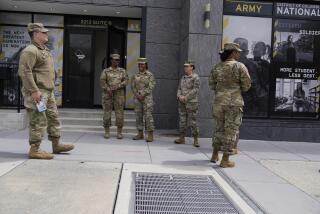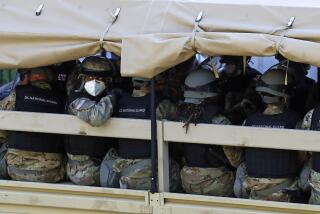U.S. to boost combat forces in Afghanistan
- Share via
WASHINGTON — U.S. officials are planning to add as many as 14,000 combat troops to the American force in Afghanistan by sending home support units and replacing them with “trigger-pullers,” Defense officials say.
The move would beef up the combat force in the country without increasing the overall number of U.S. troops, a contentious issue as public support for the war slips. But many of the noncombat jobs are likely be filled by private contractors, who have proved to be a source of controversy in Iraq and a growing issue in Afghanistan.
The plan represents a key step in the Obama administration’s drive to counter Taliban gains and demonstrate progress in the war nearly eight years after it began.
Forces that could be swapped out include units assigned to noncombat duty, such as guards or lookouts, or those on clerical and support squads.
“It makes sense to get rid of the clerks and replace them with trigger-pullers,” said one Pentagon official, speaking on condition of anonymity because the plans have not been announced. Officials have spoken in recent days about aspects of the plan.
The changes will not offset the potential need for additional troops in the future, but could reduce the size of any request from Army Gen. Stanley A. McChrystal, the top U.S. and allied commander, officials said.
McChrystal submitted a broad assessment of the Afghanistan war effort this week, calling the situation there “serious.”
Details of the assessment remain secret, but officials said it did not contain a request for more troops. Such a request could be submitted in coming weeks.
The planned changes in the U.S. troop mix are part of what military officials call a “force optimization” review, a critical middle step between the assessment and a request for additional troops, designed to ensure that the existing force is operating as efficiently as possible.
The plan reflects the view that much of the military bureaucracy that has built up in Afghanistan no longer serves a useful purpose. Services performed by troops that are no longer considered crucial could be outsourced to contractors or eliminated, officials said.
Defense officials said they would not know how many positions and jobs might be eliminated until the McChrystal review was completed. But two officials estimated the total could be 6,000 to 14,000 troops.
The review will scour the U.S. roster for situations in which several people perform the same job or for service members considered less than fully utilized, for example, working just a six-hour shift.
Army Col. Wayne M. Shanks, a spokesman for U.S. forces in Afghanistan, said that some people may no longer be needed and can be “streamlined.”
“We have asked all commands to take a hard look to reduce redundancy, eliminate any excess and generally look for efficiencies in all our structures,” Shanks said.
He declined to outline any specific groups of soldiers or Marines that were no longer needed, but said the command would not “compromise the welfare of the troops.”
Raising the overall number of U.S. troops in Afghanistan is a controversial issue.
President Obama has ordered an additional 21,000 troops to Afghanistan to bring the U.S. force to about 68,000. About 38,000 non-U.S. troops with the North Atlantic Treaty Organization are also deployed in the country.
Top Obama administration officials have sent mixed signals about whether they would approve more troops.
Complicating any decision to approve more troops is declining public support for the Afghanistan war as the number of casualties climbs, with August the deadliest month for U.S. troops there since the war began. According to a CNN poll, 57% of Americans oppose the war, up from 46% at the end of last year.
But advisors to the military command believe that McChrystal needs a larger force to carry out his counterinsurgency strategy, perhaps as many as 20,000 additional troops. Culling unneeded units would allow McChrystal to increase U.S. combat power without running afoul of political sensitivities at home.
One Defense official said the effort wasn’t designed primarily to reduce the size of any potential troop increases, but to ensure that everyone being deployed was in a “mission critical” job.
“If he is asking for more, he certainly wants to ensure we are maximizing the use of everyone that is here now,” said the official, who spoke on condition of anonymity.
Most of the dozens of combat outposts and outlying bases in Afghanistan have soldiers or Marines assigned to gates or guard towers. But the Pentagon official said those troops could be shifted to more valuable duty.
“They just stare out from the tower. So let’s bring in contractors,” the Pentagon official said. “Now you can have a thousand more troops in the field.”
Any needed job left vacant could be filled by hiring Afghans or using military contractors, officials said.
But contractors serving in some capacities, notably as security guards in Iraq, have been accused of excessive violence and wrongdoing.
In Afghanistan, a government watchdog group said Tuesday that many of the 450 private guards employed by a subsidiary of U.S.-based Wackenhut Services Inc. have engaged in lewd and drunken behavior in a “Lord of the Flies” environment. The workers guard the U.S. Embassy in Kabul, the capital, under a $189-million contract.
State Department officials said they are investigating.
Critics have charged that the military has relied too heavily on contractors in Iraq and Afghanistan, handing over too many crucial responsibilities to outsiders.
A recent Congressional Research Service found that there were more contractors than military personnel serving in Afghanistan. The report was based on figures gathered in March, before additional troops ordered by Obama began arriving.
--
More to Read
Sign up for Essential California
The most important California stories and recommendations in your inbox every morning.
You may occasionally receive promotional content from the Los Angeles Times.










